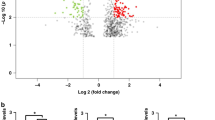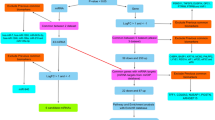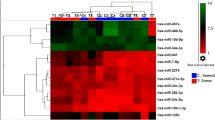Abstract
Background
Hirschsprung’s disease (HSCR) is a congenital gut motility disorder of infants, and if left untreated, it is fatal to the affected infants. This study aimed to identify key microRNAs (miRNAs), signaling pathways and genes involved in the pathogenesis of HSCR.
Methods
The miRNA microarray dataset GSE77296 was downloaded. Nine colon tissue samples were available: six from HSCR patients and three matched control samples. Differentially expressed miRNAs (DEMs) were identified after data preprocessing. Target genes of the selected upregulated and downregulated DEMs were predicted. In addition, functional enrichment analyses for the selected DEMs and target genes were conducted. Finally, interaction networks between the DEMs and target genes were constructed.
Results
A total of 162 DEMs (73 upregulated and 89 downregulated) were obtained. A total of 2511 DEM-target gene pairs for the 40 selected DEMs were identified, including 1645 pairs for the upregulated DEMs and 866 pairs for the downregulated DEMs. The upregulated DEM miR-141-3p and down-regulated DEM miR-30a-3p were identified as key miRNAs by Kyoto Encyclopedia of Genes and Genomes (KEGG) pathway enrichment and network analyses. Besides, KEGG pathway enrichment analysis revealed that pathways in cancer and the mitogen-activated protein kinase (MAPK) signaling pathway were key pathways. The key genes frizzled class receptor 3 (FZD3) and docking protein 6 (DOK6) were obtained through the DEM-target gene interaction networks.
Conclusion
Two key miRNAs (miR-141-3p and miR-30a-3p), the MAPK signaling pathway and two key genes (FZD3 and DOK6) were implicated in the pathogenesis of HSCR.
Similar content being viewed by others
References
Kapur RP. Practical pathology and genetics of Hirschsprung’s disease. Semin Pediatr Surg 2009;18:212–223.
Best KE, Addor MC, Arriola L, Balku E, Barisic I, Bianchi F, et al. Hirschsprung’s disease prevalence in Europe: a register based study. Birth Defects Res A Clin Mol Teratol 2014;100:695–702.
Leenders E, Sieber WK, Kiesewetter WB. Hirschsprung’s disease. Surg Clin North Am 1970;50:907–918.
Emison ES, McCallion AS, Kashuk CS, Bush RT, Grice E, Lin S, et al. A common sex-dependent mutation in a RET enhancer underlies Hirschsprung disease risk. Nature 2005;434:857–863.
Pan WK, Zhang YF, Yu H, Gao Y, Zheng BJ, Li P, et al. Identifying key genes associated with Hirschsprung’s disease based on bioinformatics analysis of RNA-sequencing data. World J Pediatr 2017;13:267–273.
Edery P, Lyonnet S, Mulligan LM, Pelet A, Dow E, Abel L, et al. Mutations of the RET proto-oncogene in Hirschsprung’s disease. Nature 1994;367:378–380.
Sribudiani Y, Metzger M, Osinga J, Rey A, Burns AJ, Thapar N, et al. Variants in RET associated with Hirschsprung’s disease affect binding of transcription factorsand gene expression. Gastroenterology 2011;140:572–582.e2.
Carter TC, Kay DM, Browne ML, Liu A, Romitti PA, Kuehn D, et al. Hirschsprung’s disease and variants in genes that regulate enteric neural crest cell proliferation, migration and differentiation. J Hum Genet 2012;57:485–493.
Li S, Wang S, Guo Z, Wu H, Jin X, Wang Y, et al. miRNA profiling reveals dysregulation of RET and RET-regulating pathways in Hirschsprung’s disease. PLoS One 2016;11: e0150222.
Tang W, Tang J, He J, Zhou Z, Qin Y, Qin J, et al. SLIT2/ROBO1-miR-218-1-RET/PLAG1: a new disease pathway involved in Hirschsprung’s disease. J Cell Mol Med 2015;19:1197–1207.
Lei H, Li H, Xie H, Du C, Xia Y, Tang W. Role of miR-215 in Hirschsprung’s disease pathogenesis by targeting SIGLEC-8. Cell Physiol Biochem 2016;40:1646–1655.
Smyth GK. Limma: linear models for microarray data. In: Gentleman R, Carey VJ, Huber W, Irizarry RA, Dudoit S, eds. Bioinformatics and computational biology solutions using R and bioconductor. New York: Springer New York, 2005:397–420.
Kolde R. Pheatmap: pretty heatmaps 2015. R package version 1.0.8. https://CRAN.R-project.org/package=pheatmap (accessed December 11, 2015).
Dweep H, Gretz N. miRWalk2.0: a comprehensive atlas of microRNA-target interactions. Nat Methods 2015;12:697.
Kanehisa M, Goto S. KEGG: kyoto encyclopedia of genes and genomes. Nucleic Acids Res 2000;28:27–30.
Ashburner M, Ball CA, Blake JA, Botstein D, Butler H, Cherry JM, et al. Gene ontology: tool for the unification of biology. The Gene Ontology Consortium. Nat Genet 2000;25:25–29.
Yu G, Wang LG, Han Y, He QY. clusterProfiler: an R package for comparing biological themes among gene clusters. OMICS 2012;16:284–287.
Shannon P, Markiel A, Ozier O, Baliga NS, Wang JT, Ramage D, et al. Cytoscape: a software environment for integrated models of biomolecular interaction networks. Genome Res 2003;13:2498–2504.
Opsahl T, Agneessens F, Skvoretz J. Node centrality in weighted networks: generalizing degree and shortest paths. Social Networks 2010;32:245–251.
Korpal M, Lee ES, Hu G, Kang Y. The miR-200 family inhibits epithelial-mesenchymal transition and cancer cell migration by direct targeting of E-cadherin transcriptional repressors ZEB1 and ZEB2. J Biol Chem 2008;283:14910–14914.
Uhlmann S, Zhang JD, Schwäger A, Mannsperger H, Riazalhosseini Y, Burmester S, et al. miR-200bc/429 cluster targets PLCgamma1 and differentially regulates proliferation and EGF-driven invasion than miR-200a/141 in breast cancer. Oncogene 2010;29:4297–4306.
Li H, Tang J, Lei H, Cai P, Zhu H, Li B, et al. Decreased miR-200a/141 suppress cell migration and proliferation by targeting PTEN in Hirschsprung’s disease. Cell Physiol Biochem 2014;34:543–553.
Tang W, Qin J, Tang J, Zhang H, Zhou Z, Li B, et al. Aberrant reduction of miR-141 increased CD47/CUL3 in Hirschsprung’s disease. Cell Physiol Biochem 2013;32:1655–1667.
Jiang Q, Wang Y, Shi X. Propofol inhibits neurogenesis of rat neural stem cells by upregulating microRNA-141-3p. Stem Cells Dev 2017;26:189–196.
Qiu W, Kassem M. miR-141-3p inhibits human stromal (mesenchymal) stem cell proliferation and differentiation. Biochim Biophys Acta 2014;1843:2114–2121.
Yan P, Tang S, Zhang H, Guo Y, Zeng Z, Wen Q. Palmitic acid triggers cell apoptosis in RGC-5 retinal ganglion cells through the Akt/FoxO1 signaling pathway. Metab Brain Dis 2017;32:453–460.
Takeda K, Ichijo H. Neuronal p38 MAPK signalling: an emerging regulator of cell fate and function in the nervous system. Genes Cells 2002;7:1099–1111.
Kim EK, Choi EJ. Pathological roles of MAPK signaling pathways in human diseases. Biochim Biophys Acta 2010;1802:396–405.
Tansey MG, Baloh RH, Milbrandt J, Johnson EM Jr. GFRalphamediated localization of RET to lipid rafts is required for effective downstreamsignaling, differentiation, and neuronal survival. Neuron 2000;25:611–623.
Sala CF, Formenti E, Terstappen GC, Caricasole A. Identification, gene structure, and expression of human frizzled-3 (FZD3). Biochem Biophys Res Commun 2000;273:27–34.
Deardorff MA, Tan C, Saint-Jeannet JP, Klein PS. A role for frizzled 3 in neural crest development. Development 2001;128:3655–3663.
Stuebner S, Faus-Kessler T, Fischer T, Wurst W, Prakash N. Fzd3 and Fzd6 deficiency results in a severe midbrain morphogenesis defect. Dev Dyn 2010;239:246–260.
Su L, Zhang Z, Gan L, Jiang Q, Xiao P, Zou J, et al. Deregulation of the planar cell polarity genes CELSR3 and FZD3 in Hirschsprung disease. Exp Mol Pathol 2016;101:241–248.
Crowder RJ, Enomoto H, Yang M, Johnson EM Jr, Milbrandt J. Dok-6, a novel p62 Dok family member, promotes Ret-mediated neurite outgrowth. J Biol Chem 2004;279:42072–42081.
Li WQ, Shi L, You YG, Gong YH, Yin B, Yuan JG, et al. Downstream of tyrosine kinase/docking protein 6, as a novel substrate of tropomyosin-related kinase C receptor, is involved in neurotrophin 3-mediated neurite outgrowth in mouse cortex neurons. BMC Biol 2010;8:86.
Dahal GR, Wang JX, Guo LH. Long-term outcome of children after single-stage transanal endorectal pull-through for Hirschsprung’s disease. World J Pediatr 2011;7:65–69.
Author information
Authors and Affiliations
Corresponding author
Additional information
Funding: This work was supported by Chinese Medical Bureau of Zhejiang Province (2011ZA068), Science and Technology Project of Zhejiang Province (2017KY441), and Health and Family Planning Commission of Zhejiang Province (11-CX23).
Ethical approval: The dataset used in this study is downloaded from GEO database. Our study is not involved in animal or human experiment, so there is no ethical approval.
Competing interest: None.
Contributors: Gao ZG wrote the first draft of this paper, all authors contributed to the intellectual content and approved the final version of the manuscript.
Rights and permissions
About this article
Cite this article
Gao, ZG., Chen, QJ., Shao, M. et al. Preliminary identification of key miRNAs, signaling pathways, and genes associated with Hirschsprung’s disease by analysis of tissue microRNA expression profiles. World J Pediatr 13, 489–495 (2017). https://doi.org/10.1007/s12519-017-0064-z
Received:
Accepted:
Published:
Issue Date:
DOI: https://doi.org/10.1007/s12519-017-0064-z




